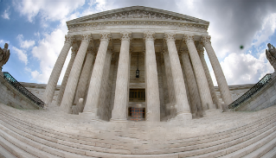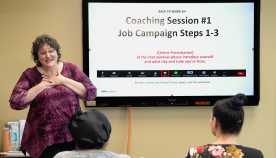About Us


The Age Discrimination in Employment Act of 1967 (ADEA) prohibits discrimination on the basis of age against individuals age 40 or older. 29 U.S.C. § 623(a)(1). Cases brought under the ADEA, as well as other federal and state anti-discrimination statutes, continue to present novel and important issues that may reach the Supreme Court.
Claims by Age Sub-Groups
As discussed in last year’s Supreme Court Preview, issues around disparate impact under the ADEA continue to divide courts. One issue that may soon come to the high court is whether a subgroup of the class protected under the ADEA—such as individuals age 50 and older—may state a valid claim of disparate impact.
Although the Supreme Court has held that the ADEA prohibits disparate treatment based on age such that a subgroup of the protected class may have a cognizable claim under the ADEA, O’Connor v. Consol. Coin Caterers Corp., 517 U.S. 308 (1996), courts of appeals are split on the question of whether that holding applies to disparate impact claims. The Eighth and Second Circuits have held that disparate impact claims are not cognizable for subgroups. See EEOC v. McDonnell Douglas Corp., 191 F.3d 948, 951 (8th Cir. 1999) (holding that “O’Connor did not address disparate-impact claims under the ADEA” and does not have “any relevance” to disparate impact claims); Criley v. Delta Air Lines, Inc., 119 F.3d 102, 105 (2d Cir. 1997) (rejecting disparate impact claims by pilots age 55 and older). In contrast, the Third and Seventh Circuits have applied O’Connor to disparate impact claims. See Karlo v. Pittsburgh Glass Works, LLC, 849 F.3d 61, 71 (3d Cir. 2017) (reasoning that the disparate impact provision of the ADEA uses the same operative language as the disparate treatment provision interpreted in O’Connor); O’Brien v. Caterpillar Inc., 900 F.3d 923, 930 (7th Cir. 2018) (applying similar reasoning).
Now, a case presenting the same question is winding its way through courts in California and may ultimately further contribute to the circuit split. In that case, a former employee sued Twitter, alleging that, in the course of the mass layoffs following Elon Musk’s purchase of Twitter, the company willfully discriminated against him and other employees over age 50 in violation of the ADEA and the New York State Human Rights Law. The court agreed with the Third and Seventh Circuits, finding that the disparate impact claim is cognizable for the 50-and-older subgroup. Zeman v. Twitter, Inc., No. 23-CV-01786-SI, 2023 WL 5599609, at *5 (N.D. Cal. Aug. 29, 2023). The plaintiff has moved to certify a class of similarly situated employees.
Arbitration
Another issue that may make its way to the Supreme Court is whether an arbitration agreement can be used to bar an employee from pursuing a claim under the ADEA. Currently, there is a circuit split on the issue. The Second Circuit has held that the comprehensive timing scheme for filing an ADEA claim is a procedural right that can be waived in an arbitration agreement. In re IBM Arb. Agreement Litig., 76 F.4th 74 (2d Cir. 2023). The Sixth Circuit, on the other hand, has determined that the timing scheme is a substantive right that cannot be waived by contract. Thompson v. Fresh Products, LLC, 985 F.3d 509 (6th Cir. 2021). The plaintiffs sought review of the Second Circuit decision earlier this year, however, the Supreme Court denied certiorari. Abelar v. Int'l Bus. Machines Corp., 144 S. Ct. 827 (2024). Nonetheless, the ubiquity of arbitration agreements and the disagreement among circuits likely means that this issue will arise again and may soon be taken up by the high court.
Artificial Intelligence
A rapidly growing novel area in employment law involves the use of artificial intelligence (AI) in hiring processes. In one case, Mobley v. Workday, No. 3:23-cv-00770, 2024 WL 3409146 (N.D. Cal. July 12, 2024), a class of plaintiffs sued Workday, the developer of algorithm-based applicant screening tool, for discrimination on the basis of race, age, and disability. The lead plaintiff, Derek Mobley, a Black man over age 40 who suffers from anxiety and depression, asserted he applied 80 to 100 jobs for which he was qualified at companies that use Workday’s screening tools and did not receive any job offers. Mobley, 2024 WL 3409146, at *1. The plaintiffs assert claims under Title VII of the Civil Rights Act of 1964, the ADEA, and the Americans with Disabilities Act (ADA), alleging that Workday’s program is “designed in a manner that reflects employer biases and relies on biased training data.” Id. In rejecting Workday’s second motion to dismiss, the district court stated that an employer’s agent may be independently liable when the employer has delegated to the agent functions [that] are traditionally exercised by an employer.” Id. at *3-5. The court then found Workday could be held liable as an agent of employers using its software because Workday’s software screens and rejects applicants, which are functions traditionally performed by the employer. Id. at *5. Although still in its early stages, this case presents novel claims related to AI and agency relationships as well as potential claims regarding intersectionality. As the use of AI becomes more widespread and its possible discriminatory impacts become better understood, this bellwether case may present an opportunity for the Supreme Court to weigh in on these issues.
Narrowing of the Honest Belief Defense
Another significant development pertains to the “honest belief” rule, a defense to employment discrimination and retaliation claims. The doctrine provides a defense to employers who have an “honest belief” that an employee engaged in conduct justifying adverse action.
The Eighth Circuit recently issued a decision narrowing the scope of the honest belief defense. In Huber v. Westar Foods Inc., 106 F.4th 725 (8th Cir. 2024), an employee alleged that she was unlawfully denied leave under the Family Medical Leave Act and terminated because of her diabetes in violation of the ADA. Specifically, after waking up with symptoms of hypoglycemia, she went to the hospital and failed to call her employer to report her absence that day. The court found that the honest belief rule could not preclude the employee’s ADA claim from going forward unless the employer could show that the underlying reasons for her discharge were “‘sufficiently independent from’ [her] protected status or activity.” Huber, 106 F.4th at 737 (quoting Gilooly v. Missouri Dep’t of Health & Senior Servs., 421 F.3d 734, 740 (8th Cir. 2005). The court explained that the rule does not apply where “an employer’s adverse employment action is ‘so inextricably related to’ the disability, [that] ‘they cannot be considered independently of one another.’” Id. (quoting Womack v. Munson, 619 F.2d 1292, 1297 (8th Cir. 1980)).
Although the Eighth Circuit found in favor of the employee, one judge wrote a partial concurrence and partial dissent, disagreeing with the majority’s narrowing of the rule, saying it ran afoul of the ADA’s causation principles. Huber, 106 F.4th at 748-49 (J. Stras, concurring in part and dissenting in part). While this decision could increase employment protections for employees, the employer filed a petition requesting that the Eighth Circuit rehear the case en banc. This leaves open the possibilities that the Eighth Circuit vacates the decision and that the issue will ultimately be appealed to the Supreme Court.
Lauren Naylor, LNaylor@aarp.org
Allie Horwitz, AHorwitz@aarp.org
View the Full Supreme Court Preview

















